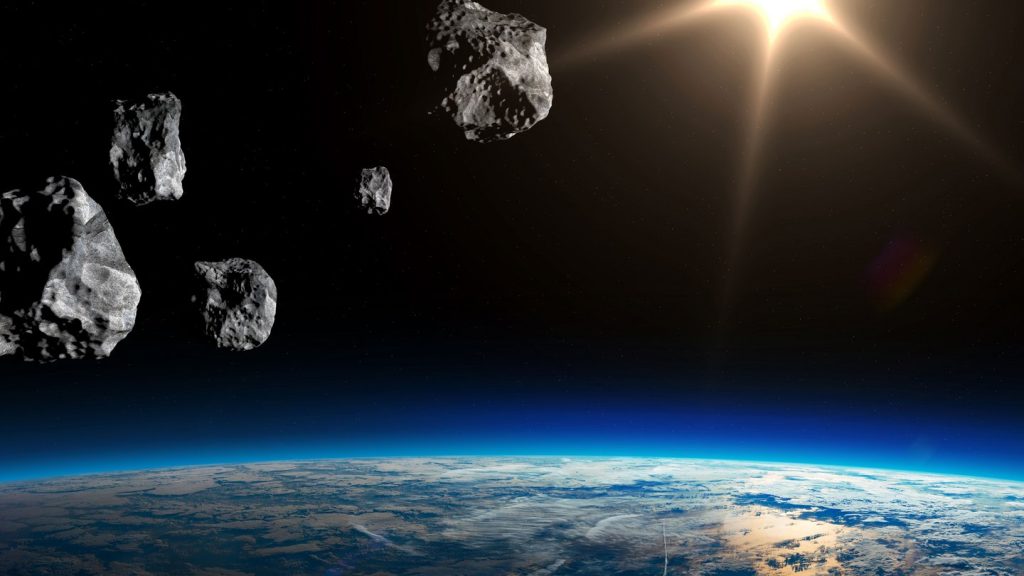Planetary researchers have been baffled by the formation of rocks on Earth for some time. Because although the Earth was originally formed from the same material as the asteroids, the atomic composition of the Earth’s crust is different from that of other smaller celestial bodies. A team of researchers has now examined the frequency of certain types of atoms in different meteorites and compared them to samples from Earth. They found a possible explanation for the differences: It is possible that torrential rains from meteorites repeatedly eroded Earth’s crust in its formation phase and thus changed its composition, the researchers reported in the journal Science.
About 4.5 billion years ago, our solar system formed from a disk of gas and dust. First, countless smaller celestial bodies formed, which then gradually collided with each other and grew into asteroids, moons and planets. Hundreds of thousands of collisions between small bodies were necessary to form a planet like ours. Paul Frossard at the University of Clermont-Auvergne in Clermont-Ferrand and ETH Zurich and colleagues now wanted to better understand the processes that played a role in this. To do this, they examined meteorites in which the original atomic structure of matter was preserved exactly as it was when our solar system formed.
First, the researchers determined how common the specific isotopes are in both terrestrial rocks and meteorite materials. Isotopes are variants of a particular element that differ only in the number of neutrons in their atomic nuclei. Frossard and colleagues were particularly interested in the ratio of two isotopes of the rare earth metal neodymium – neodymium-142 and neodymium-144. Both isotopes occur naturally, although the lighter neodymium-142 can also be formed during the radioactive decay of the element samarium.
As the analyzes showed, terrestrial rocks contain more neodymium-142 than neodymium-144 than meteorites. After researchers were able to rule out other explanations with the help of more measurements, there was one valid explanation for this relationship: Unlike asteroids and comets, Earth – just like other large celestial bodies – went through geochemical processes: heavy elements such as iron and nickel sink into the Earth’s core, accumulating Silicates in the upper mantle and in the Earth’s outer crust. Both neodymium and samarium prefer to combine with silicates, even if they are among the heavy elements – neodymium with those in the Earth’s crust, and samarium with those in the Earth’s mantle. Therefore, according to the researchers, these elements accumulated there in the primitive times of our planet.
Due to the constant bombardment by smaller orbs, the crustal material often eroded away and escaped into space. This lowered the proportion of neodymium in the Earth’s crust – until the constant meteor showers eventually subsided. Meanwhile, samarium remained deeper in the ground, where it was better protected. Over the course of millions of years, it decayed into the isotope neodymium-142 and then made its way to the Earth’s crust – at a time when no meteorites ever hit the Earth. As a result, an increased proportion of neodymium 142, the decay product of samarium, can be found in the Earth’s crust today.
From comparing numerical proportions, the researchers concluded that it appears that up to 20 percent of the material from young Earth escaped into space as a result of such collisions—in other words, there was massive erosion of the Earth’s surface. This process could also explain why other elements such as uranium, potassium, and thorium are less common in the Earth’s crust than expected.

“Social media evangelist. Baconaholic. Devoted reader. Twitter scholar. Avid coffee trailblazer.”








More Stories
Longest jets in the universe discovered – giant particle streams as long as 140 Milky Way galaxies in a row
New method reveals 307 supernova remnants
Snapchat is upping the ante on augmented reality glasses